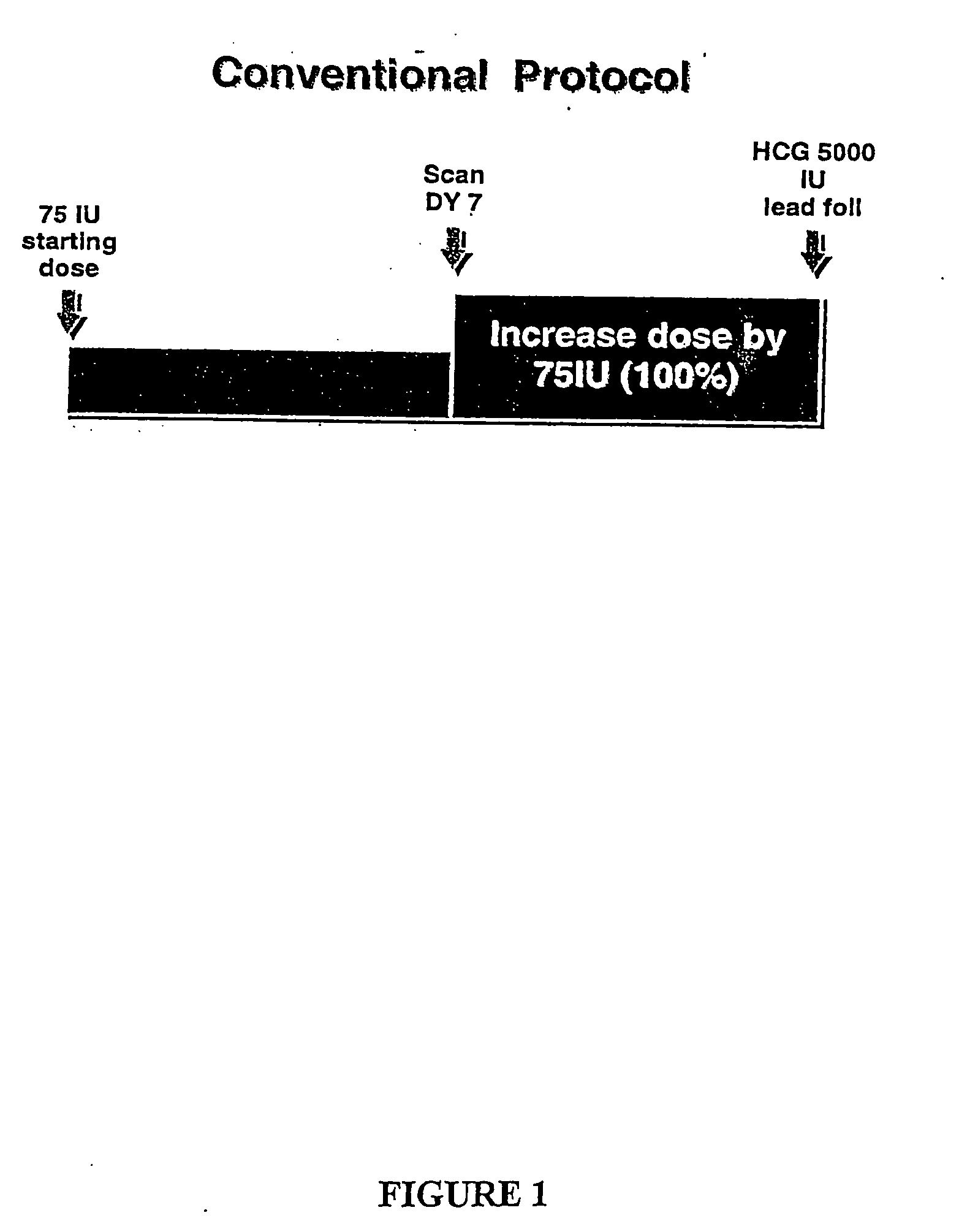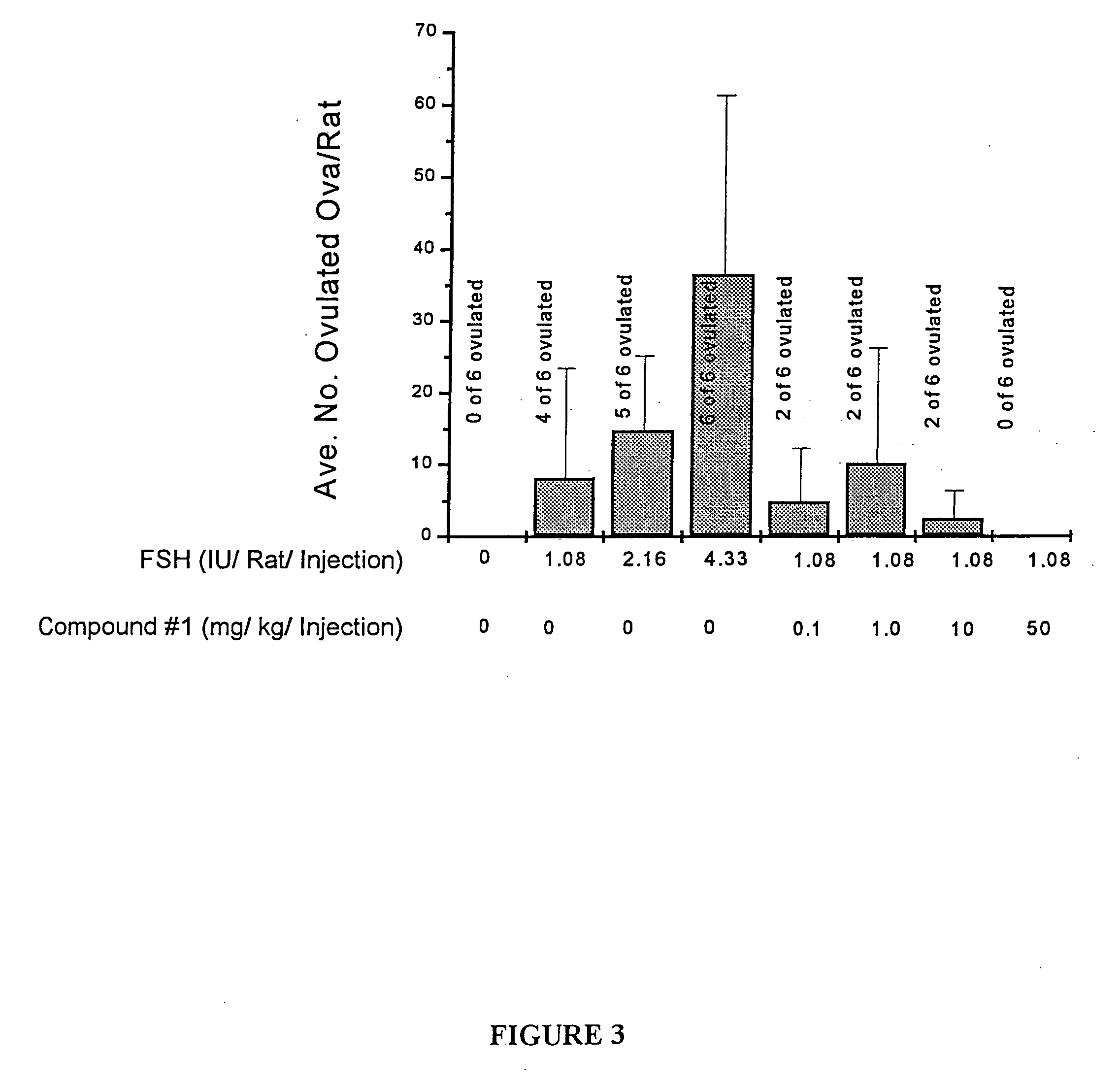Methods of inducing ovulation
a technology of ovulation and phosphodiesterase, which is applied in the field of methods of inducing ovulation, can solve the problems of affecting the ovulation of mice deficient in a particular phosphodiesterase, reducing the sensitivity of granulosa cells to gonadotropins, and over-stimulating the development and maturation of follicles
- Summary
- Abstract
- Description
- Claims
- Application Information
AI Technical Summary
Benefits of technology
Problems solved by technology
Method used
Image
Examples
example 1
Effect of Compounds 1 and Compounds 2 on Rat Ovarian Granulosa Cell CAMP Levels, Alone or with Gonadotropins In Vitro
[0120] Ovaries were removed from immature 25 day old, hypophysectomized, diethylstilbesterol treated Sprague-Dawley rats. The ovaries were repeatedly punctured with 27 gauge needles to liberate granulosa cells from the follicles. Cells were washed and re-suspended in McCoys 5A media+0.1% BSA+2 μM androstenedione. Viable cells in number of 100,000 were loaded into 6-well tissue culture dishes in a 1.0 ml volume (with Compound 1 and Compound 2 at a concentration of 25 micromolar, either alone or in conjunction with a low, 0.1 pM dose of gonadotropin). Plates were incubated in a 37° C. incubator, 100% humidity, 5.0% CO2 for 48 hrs. Conditioned media were assayed in a CAMP specific RIA. Results are expressed as mean plus or minus standard deviations. As seen in FIG. 2, Compounds 1 and 2 cause a significant increase in CAMP levels in the presence of sub-effective concentr...
example 2
Effect of the PDE Inhibitor Compound 1 on Follicle Maturation In Vivo
[0121] Mature ovarian follicles generated in immature female rats by treatment with a sub-optimal dose of FSH (1.08 IU / rat / injection; bid×3 days) with and without co-administration of Compound 1 (0.1, 1, 10, and 50 mg / kg / injection: bid×3 days). A single injection of an ovulatory dose of hCG (20 IU) was administered with the final FSH injection. The PDE inhibitors were given in conjunction with sub-optimal doses of FSH.
[0122] All injections were subcutaneously administered. Ovulation was determined 18 hours after hCG administration by counting oocytes in oviduct. Results are expressed as mean plus or minus standard deviations. As seen in FIG. 3, data represent average number of oocytes in oviducts of all rats in each group and frequency of ovulating rats. As also noted in FIG. 3, a PDE inhibitor (Compound 1) inhibited (rather than stimulated) both ovulation administered at 50 mg / kg. The results demonstrate that in...
example 3
Effect of the PDE Inhibitor Compound 1 on Ovulation, in the Presence of a Sub-Effective Dose of hCG In Vivo
[0123] Mature ovarian follicles generated in immature female rats by treatment with an effective dose of FSH (2.16 IU / rat / injection; bid×2 days) were induced to ovulate with a single injection of hCG. hCG was administered at a sub-effective dose (3 IU) with and without a single injection of Compound 1 (50, 10 and 1 mg / kg) at the time of the final FSH injection. Ovulation was determined 18 hours after hCG administration by counting the number of ova in the oviduct. As seen in FIG. 4, a single injection of Compound 1 co-administered with a sub-ovulatory dose of hCG resulted in an induction of ovulation. All injections were subcutaneous. Results are expressed as mean plus or minus standard deviations. This data demonstrates that a non-polypeptide CAMP level modulator, in this case a PDE inhibitor enhances hCG-stimulated ovulation when a sub-optimal dose of hCG is administered. Th...
PUM
| Property | Measurement | Unit |
|---|---|---|
| diameter | aaaaa | aaaaa |
| diameter | aaaaa | aaaaa |
| diameter | aaaaa | aaaaa |
Abstract
Description
Claims
Application Information
 Login to View More
Login to View More - R&D
- Intellectual Property
- Life Sciences
- Materials
- Tech Scout
- Unparalleled Data Quality
- Higher Quality Content
- 60% Fewer Hallucinations
Browse by: Latest US Patents, China's latest patents, Technical Efficacy Thesaurus, Application Domain, Technology Topic, Popular Technical Reports.
© 2025 PatSnap. All rights reserved.Legal|Privacy policy|Modern Slavery Act Transparency Statement|Sitemap|About US| Contact US: help@patsnap.com



